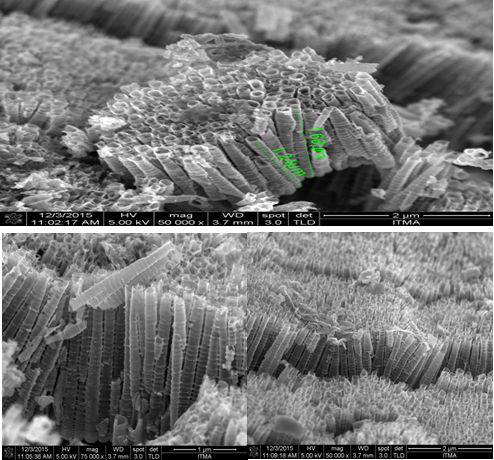Palm oil is one of the major contributors to the Malaysia economy. The quality of palm oil is very important to be examined and one of the quality indices is the free fatty acid content. Thus, in this study titania nanotubes (TNTs) modified electrode was prepared for the determination of fatty acid. Fabrication of TNTs as a working electrode was carried out using anodization technique with modification of some parameter conditions to produce one-dimension nanomaterial. Investigation on the effect of electrolyte, duration, and voltage of anodization showed that fabrication of TNTs using glycerol at applied potential of 30 V and 2 hours produced a good array of nanotubes and better diameter around 65 nm to 85 nm and the wall thickness in the range of 15 nm to 18 nm. Empirical formula for TNTs is TiO2, it exhibits anatase phase and possess tetragonal structure. Electrochemical characterization showed that the TNTs produced 2-time greater current enhancement and active surface area of 0.0711 cm2.
The voltammetric behavior of naphthaquinone in the presence of palmitic acid at the TNTs modified electrode was also investigated in an acetonitrile/water (1:1) solution containing 0.1 M LiClO4. The proposed method is based on the voltammetric reduction of 2-methyl-1,4-naphthaquinone in the presence of acid. The developed method shows good linearity towards the concentration of palmitic acid in the range of 2.3 mM to 6.2 mM (R2 = 0.9862) with a detection limit of 1.006 mM. The developed method was compared to the standard method for the determination of palmitic acid and a correlation of R2 = 0.6110 between both methods was obtained. The reproducibility and repeatability studies were also carried out and the RSD of 2.48% and 5.49% were obtained.

Figure: Cross-section of Titania Nanotubes prepared at 30 V for 2 hours.
*Abstract of the thesis (Master) by Nor Hidayat binti Yusof.
For further information please contact:
Jaafar Abdullah, PhD
Chairman
jafar@upm.edu.my
Date of Input: 25/02/2022 | Updated: 25/02/2022 | roslina_ar
MEDIA SHARING























